
I study trees, dendrology, as a tree enthusiast. I am particularly interested in the features of different tree species and how helpful these features are for identifying one tree species from another. So, when I went to France for the first half of September to be with beloved family, I could not drop my fascination with trees and plants with a “Je ne comprends pas.”
The soil, climate, geography, elevation, wind, and sunlight of the mountainous area in southwest France that I visited first are very different from these attributes here on British Columbia’s West Coast. I was in Aveyron, a department of France in Occitanie, the large administrative region that used to be called Midi-Pyrénées and Languedoc-Roussillon. Occitan was a language spoken in parts of southern France, Spain, and Italy, and in Monaco; in France it is kept alive at the educational level, but not legally. Now the name Occitan is also used by the luxury personal products company, L’Occitane.
Because of the French environment and aesthetic, it took me a while to recognize some tree species that I know well, trees such as Douglas-firs, which have been imported to France, and horsechestnuts, native to Greece and Albania, and imported to both Canada and France.
Here are some of the vines, shrubs, and trees I identified, starting in Aveyron and then moving (by train) to Paris.
The rich orange-red flowers of Madame Galen trumpet vine (Campsis x tagliabuana ‘Madame Galen’) were climbing everywhere—over the fence between our son’s property and his neighbour’s, in front gardens, and here, beside one of the many crosses that are ubiquitous in France. This one was in Belcastel, Aveyron. (Please ignore the invasive ivy (Hedera spp.), which was also ubiquitous.)
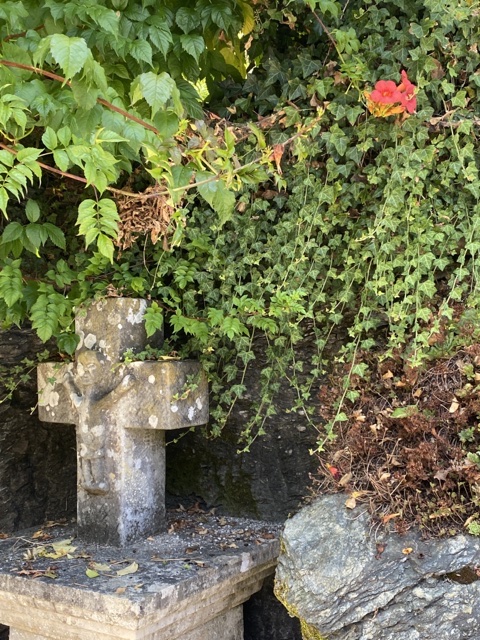
Two of my grandchildren and I climbed from the highway up to the Abbey Church of Sainte-Foy in Conques, Aveyron. The route used to be part of the pilgrim path known as the Camino de Santiago; shell icons were evident along the way. Along the climb, I noticed these butternut squash tumbling over a stone wall as they grew. Taking their photo provided a moment’s rest on a scorching hot day. 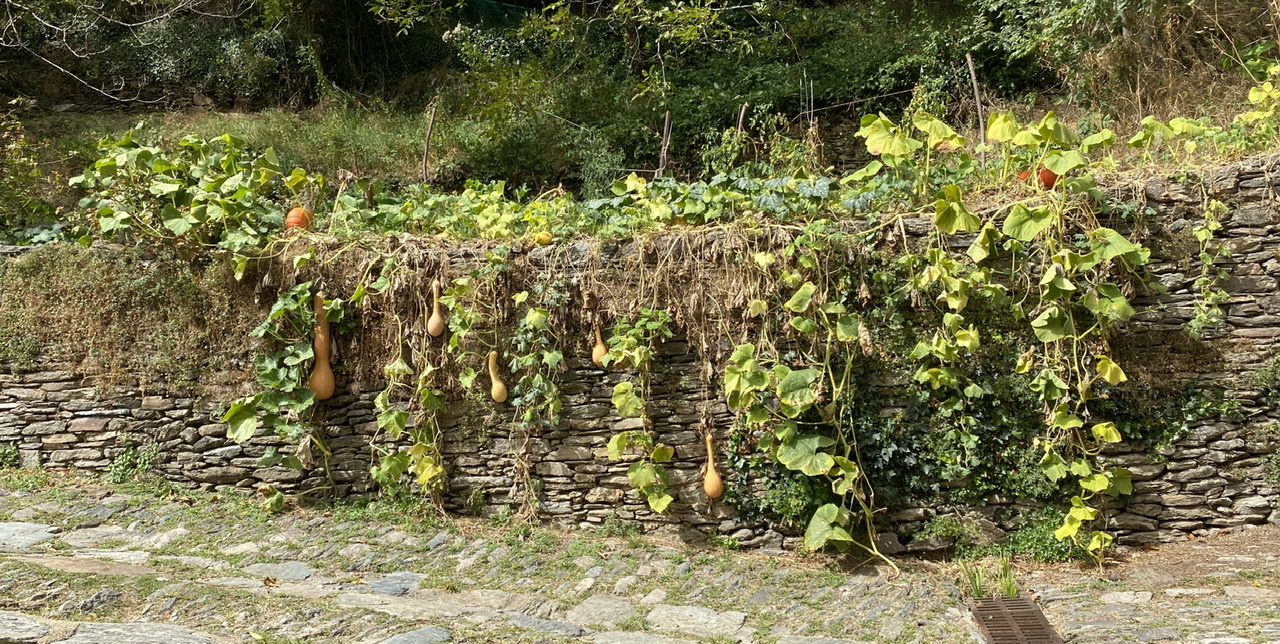
When we reached the top, it was beautifully cool inside the Romanesque abbey church itself.
Back in our son’s village, I noticed baskets of deep pink geraniums brightening this staircase, contrasting with the iron railing, the stone walls, and the flagstone courtyard.
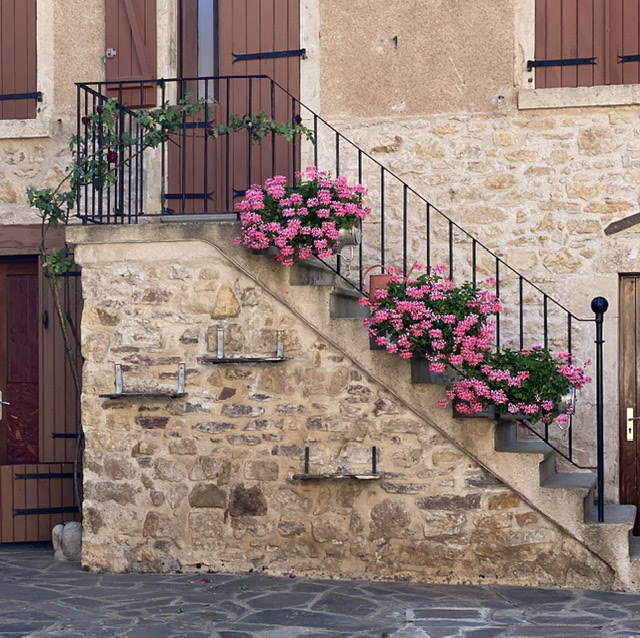
French formal gardens are an art form. This one is in Albi, visible through a window in the Musée Toulouse-Lautrec, dedicated to Comte Henri de Toulouse-Lautrec. He was a formidable artist born in Albi. His works—paintings, posters, caricatures—provide a way to observe life in the late nineteenth century in his native department of Aveyron and more famously in the nocturnal entertainment life of Paris.
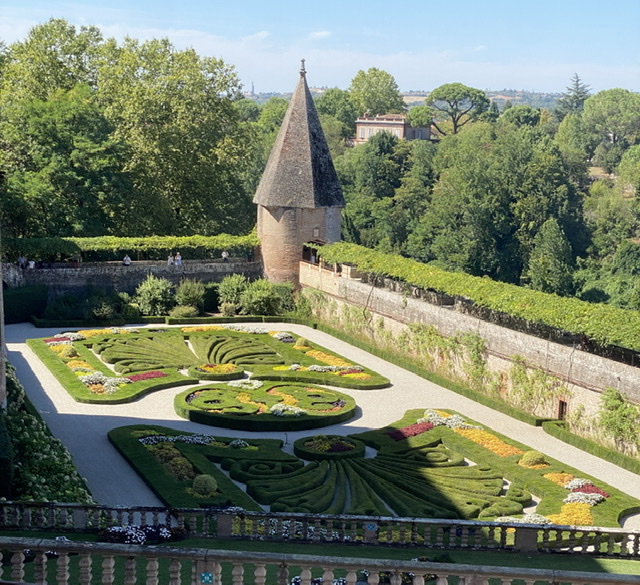
The hybrid trees that many of us know as London plane trees (Platanus x hispanica) found their way into France some centuries ago. Now they grow tall and line many highways. They also flourish successfully as pollarded trees in many town and village squares. Pollarding is the process of lopping off the branches of a tree just where they emerge from the trunk. When the tree is young, the vigour in the trunk causes the tree to grow many leafy branches. It’s a distinctive look that is often seen in France. I took the photo of the three below—with their mottled camouflage trunks—in the charming village of Bournazel, Aveyron.

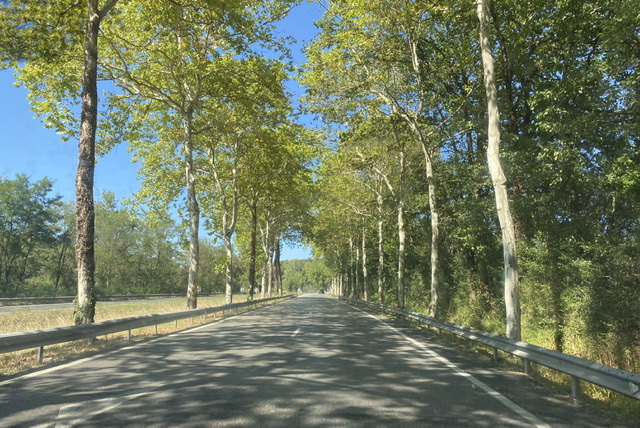
As we made our way north by train from the farming region of Occitanie in southwest France, we noticed castles, churches, and villages nestling themselves among broadleaf forests. Gradually the productive land gave way to open fields and windmills and industry, until eventually we arrived in Paris. We began exploring by metro and on foot.
Here in Île de la Cité, over a resuscitating coffee, hot chocolate, and croissants, I recognized a catalpa tree; it was hanging its cigar-shaped fruit over the tables. (Not us in the photo!)
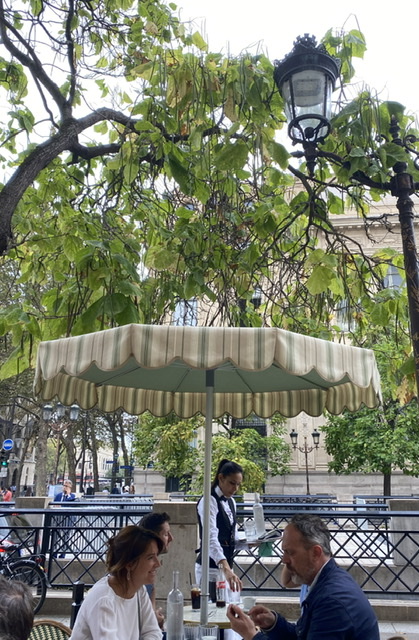
Walking up to Sacré-Cœur from our Montmartre rental apartment, we passed a princess tree, Paulownia tomentosa, in bud. Notice the many pigeons on its branches.
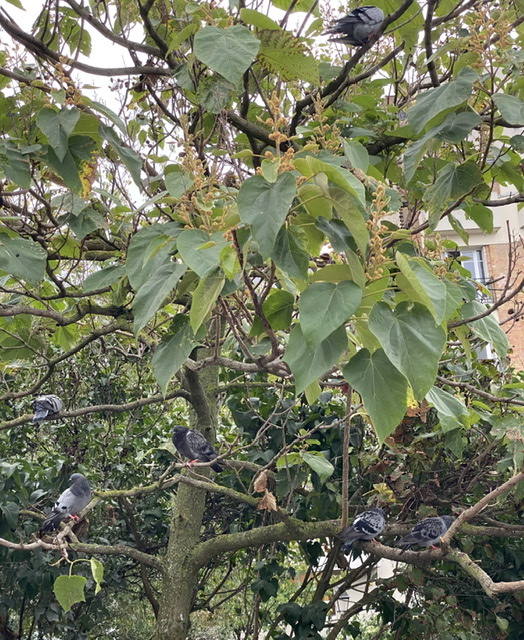
Another more frequently noticed princess tree grows beside Moulin de la Galette, a windmill of Montmartre made famous by the brown bread made there.
Montmartre is the mountain of the martyr, Saint Denis, now the patron saint of France; but it is better known today as an artist’s district where you can have your portrait painted for fifty euros, more or less.
Nearby is Montmartre Cemetery, burial place of many famous people:
- Jacques Offenbach, nineteenth-century composer of nearly a hundred operettas;
- Vaslav Nijinsky, Russian ballet dancer;
- Hector Berlioz, French Romantic composer and conductor;
- Russian Princess Soltikoff;
- and many more.
The cemetery is also home to some familiar trees:
western white pine, Pinus monticola;
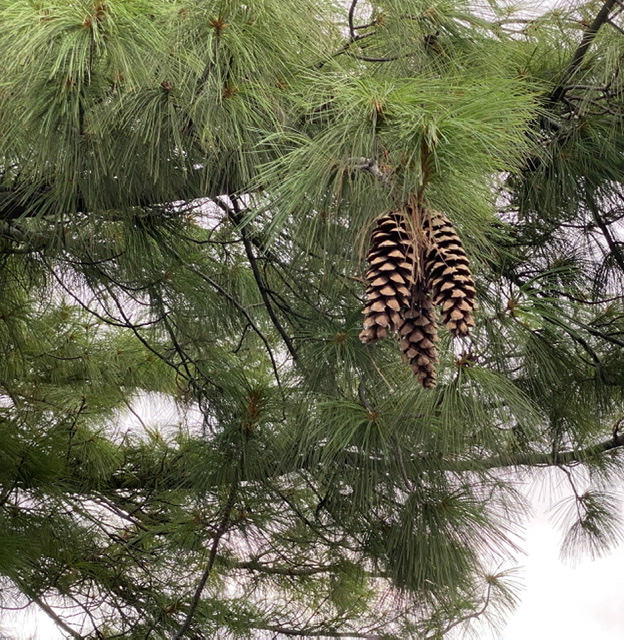
horsechestnut trees, Aesculus hippocastanum, in avenues;
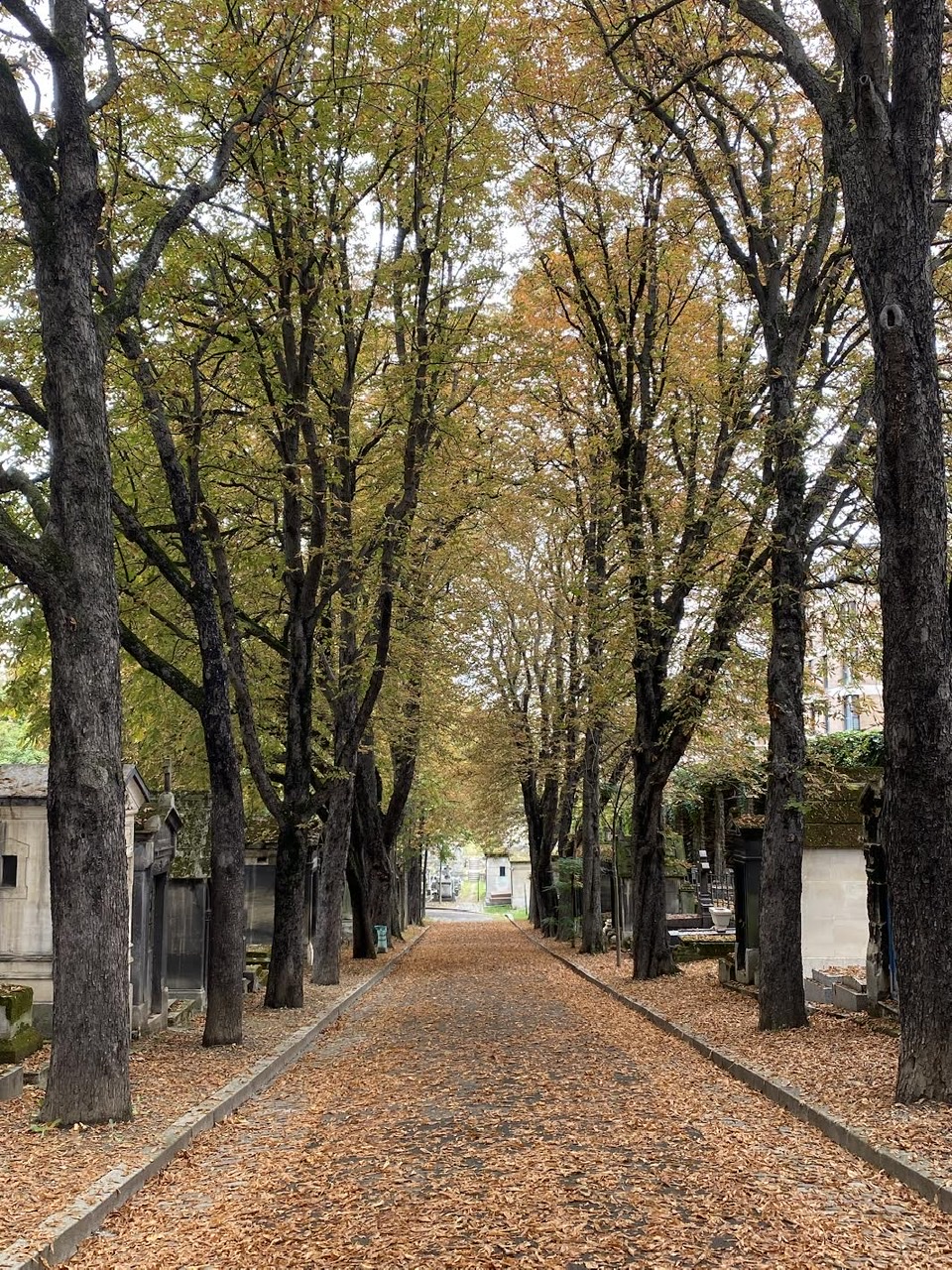
goldenrain tree, Koelreuteria paniculata; and

common fig, Ficus carica.
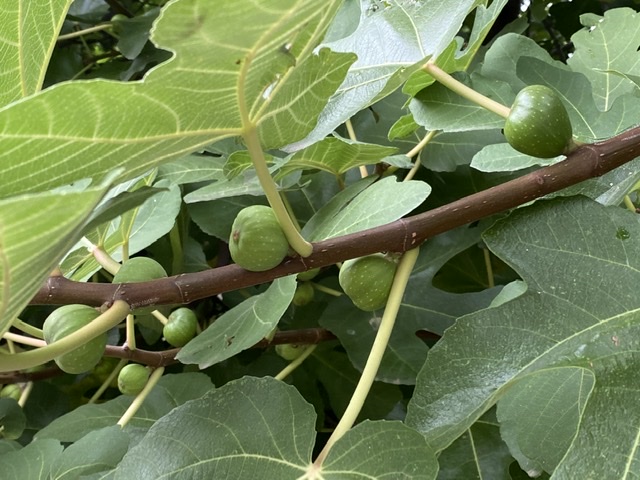
Did you know that the “fruit” visible on the fig tree is actually the flower? It will become a fruit once a wasp that has specialized itself for the purpose enters many flowers to gather nectar and thereby pollinate each one. These “flowers” then become the fruit that many of us love.
This photograph of the formal garden at Place des Vosges shows a fountain, a trimmed evergreen, and two sides of the residential housing that began in the seventeenth century as royal city planning. Please notice the two strict rows of pollarded linden trees, Tilia spp.
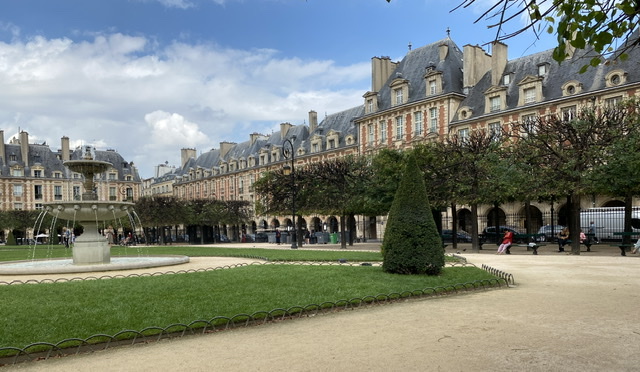
Jardin du Luxembourg is one of Paris’s largest gardens. Queen Marie de Medici decreed these gardens be created in 1612 in the style of the Boboli Gardens in Florence, her native home. There are formal lawns, tree-lined promenades, and a small, fenced-off orchard of apple, pear, and persimmon trees. This cedar of Lebanon, Cedrus libani, in the Luxembourg Garden boasts blue-green needles and male pollen cones. Its overall blueness is the result of the needles’ many stomata (openings for gas exchange) closing to keep out the scorching heat of the sun.
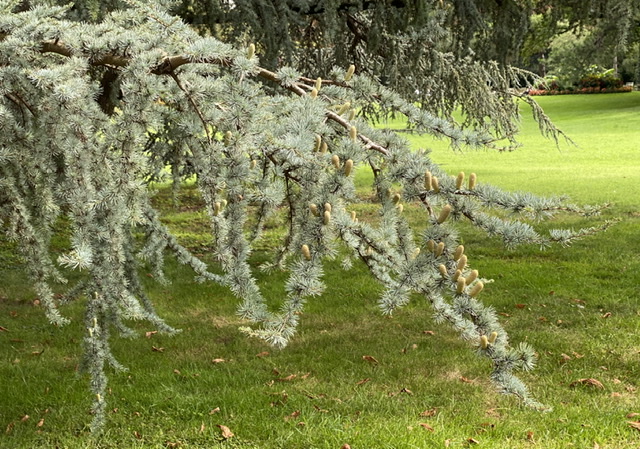
We also visited the Jardin des Tuileries. This is another formal garden where people can walk and picnic. However, “Pelouse Interdite,” means “lawn prohibited” or “forbidden lawn.” In other words, do not walk on the grass and certainly don’t sit or picnic on it. 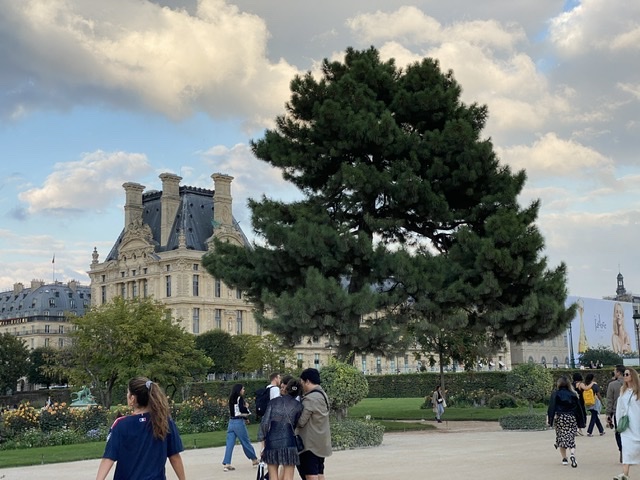
Some of the mature pine trees growing in the Tuileries look almost disrespectful as a foreground to the Tuileries Palace, leaning and growing randomly, as pines are wont to do. Perhaps my West Coast of Canada eye was becoming swayed by France’s tidy tree aesthetic.
Text and photos by VMG Nina S.